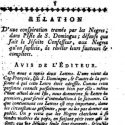As a 2018–2019 NULab Fellow, I worked with the Early Caribbean Digital Archive (ECDA) to investigate disability and slavery in eighteenth- and nineteenth-century texts, studying how we can read, represent, and understand this complex history. The ECDA focuses on decolonizing the archive through remix and reassembly, using the affordances of a digital archive to create new representations, curations, and connections for historic materials.
Using this theoretical position as critical practice, I began my research with a survey of the archive, looking for texts where facets of ability and disability were both mentioned and conceptualized. When working with historic documents, one of the most important yet challenging components is deciding how to apply contemporary concepts to historic materials. Following Sari Altschuler and Cristobal SIlva’s theoretical framework for a disability studies reading of early American texts in “Early American Disability Studies,” I explored ability and disability in James Grainger’s The Sugar-Cane: A Poem and An Essay on the Most Common West-India Diseases. Grainger, a physician from the UK who worked on plantations in the Caribbean, combined natural history and medical knowledge in these texts. In my reading of Grainger, I explored the material and historic structures that disorder and classify bodies in physician’s journals, such as the empty casebook page (akin to our medical charts today) where a person’s health and ability were defined by disorder, ending in either cures or death. While Grainger’s medical text, An Essay, is a manual for plantation physicians and not a working roster of individuals, it reads as a symbol of the silenced voices and bodies that exist in the archives and must, as Altschuler and Silva note, continue to be examined.
However, this exercise in examining historic documents raised even further questions about practice: how can we reframe, revalue, and re-imagine historic knowledge and narratives? Are there ways that digital forms of exhibition and storytelling can facilitate this? The ECDA works to decolonize and reclaim silenced voices in the archive, in particular, the voices of enslaved individuals whose narratives are within colonial narratives. However, in thinking about positionality, materiality, and the body, there are further ways and needs to examine the connections between historic texts, individual narratives, and representations of ability across narratives. These questions led to the second part of my research: theorizing and planning a digital exhibit on the Haitian rebellion leader François Makandal.

